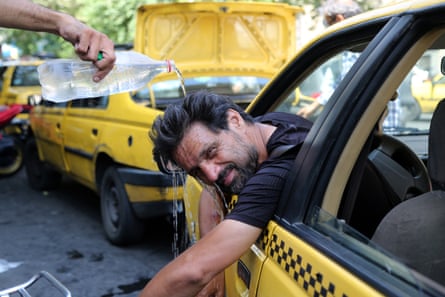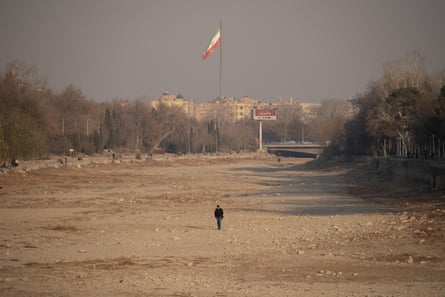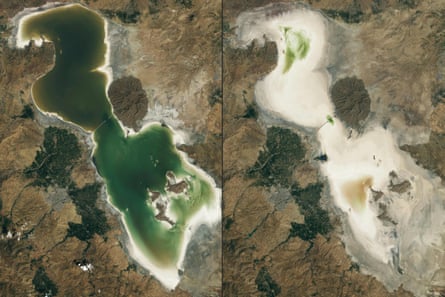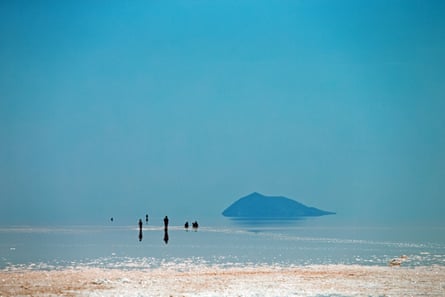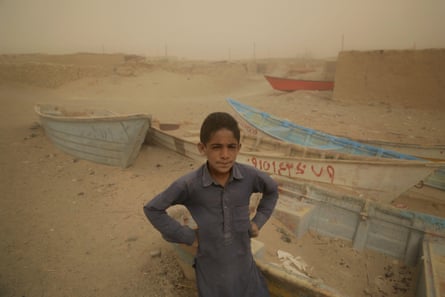‘We must change’: how drought and overextraction of water has run Iran dry
September 21, 2025
-
Iran’s vital statistics
A month ago, Benjamin Netanyahu pitched a calculated deal to the Iranian people. The Israeli prime minister suggested that if Iranians took to the streets and overthrew their government, he would flood the country with Israel’s top water experts, bringing with them cutting edge technology able to recycle and desalinate Iran’s water.
Netanyahu clearly felt he had shaped his appeal to highlight one of the Iranian government’s great vulnerabilities, and on that he was right, even if he was precisely the wrong man to make such a pitch.
Iran is facing multiple resource crises brought on by climate change, sanctions, successive mistakes and neglect by government. Blackouts, planned or unexpected, occur most days in dusty Tehran, even, ironically, at the US embassy, once the nerve centre of the defeated imperialists.
The president, Masoud Pezeshkian, is disarmingly open about the scale of the crisis. “There is currently a problem with water, electricity and gas. There is no water behind the dams. The wells beneath our feet are also running dry. Those who claim there is water should come and tell us where this water is …”
For five years, Iran has been struggling with a drought that, experts agree, has been made far more severe by climate change. Steadily dropping levels of rainfall – a sweltering Tehran had only 158mm of rainfall last year, 42% less than the long term average – have combined with excessive consumption, particularly in agriculture, plus mass unauthorised extraction of groundwater and a fondness for prestigious but faulty engineering projects.
The water is running frighteningly low and this summer no fewer than 19 of Iran’s dams had only between 3 and 15 % of their water left. The capital’s three dams – Lar, Malu and Amir Kabir – were at critical levels by September, but appeals to the citizens of Tehran to cut their water consumption by 25% have not yet worked, so now there are plans to halt all construction work in the city for two years. Iran is now on the brink of the taps running dry.
In an interview with the Guardian in her Tehran offices, Shina Ansari, Iran’s vice-president and head of the government’s Environmental Protection Agency, does not disguise the gravity of the crisis. “Iran is located in the so-called dry belt of the Earth, and we have faced challenges for a long time, but over the past three decades the temperature has risen by 1.8C and over the past five years there has been a 30% reduction in rainfall. Right now we are in the fifth consecutive year of near drought.”
There have been mistakes in the past, she says, such as locating water-consuming industries in dry areas, or placing large populations in areas that do not have enough water resources. “Due to the major limitations that we face, we have no other choice but to change some of our agricultural methods.” This, she admits, is socially sensitive.
Everywhere the symptoms of water shortages are clear to see, including evaporating lakes, dried out dams, massive land subsidence in ancient cities such as Isfahan, or cracks on the main rail line between Tehran and Mashhad. On government lawns, sprinklers have been turned off. The pressure reduction means water doesn’t reach high-rise flats in tower blocks. Even the productivity of palm trees in Iran’s great agricultural hub Abandan in the south of Iran has halved due to excess salt in the water.
Subsidence, says Mehdi Jamalinejad, governor of Isfahan, a city of architectural treasures inhabited by more than 5 million people, “is no longer an earthquake that has been extinguished, but rather an erupting volcano.” Nine main metro stations in Isfahan, 274 main fire department junctions, 328 mosques, 37 libraries, three main hospitals, one hotel and 258 schools are located in areas with high subsidence, he tells the Guardian. Forty schools have been evacuated, and many of them were demolished due to intensified subsidence. In the last week alone, three subsidence incidents in the centre of Isfahan caused sinkholes of 7 to 15 metres in public pathways.
Overextraction is a critical part of the issue, says Issa Kalantari, a former agriculture minister who has been warning Iran of the coming crisis for 20 years. “In the Isfahan city basin, we annually extract 1.1bn to 1.2bn cubic metres of water from the Earth and use it for agriculture. This excessive extraction of groundwater resources has greatly contributed to the subsidence of Isfahan. We now have 23bn cubic metres of “air” in an area of up to 2,700sq km in Isfahan city and the Gavkhoni wetland. This is extremely dangerous, because this figure means that there is a 10-metre underground void that constantly causes subsidence in Isfahan city. This is why Isfahan’s historical monuments, roads, refineries, power plants and even its schools and houses are being destroyed.”
But the single dramatic and tragic example is the near complete evaporation of the turquoise Lake Urmia in north-western Iran, once the Middle East’s largest lake and the world’s sixth largest saltwater lake. A tourist destination 20 years ago, it now has a water depth of only half a metre. The effects of the long drought and rapid evaporation in the high temperatures have combined with excessive dam production and agricultural overproduction.
Despite the preparation of innumerable comprehensive rescue plans, including taking water from the Caspian Sea, or paying farmers to stop using so much water, it is possible the lake will no longer exist by the end of this summer if current conditions persist. In fact, according to Banafsheh Zahrai, the head of the Water Institute at the University of Tehran, the lake has already reached a “point of no return”, due in large part to the irrigation of ever expanding farmland around it. And its loss will have a multiplier effect she warns: “The consequences of the drying up of Lake Urmia do not end with just warmer regional weather or turning into salt flats; rather, similar to the experience of the drying of the Aral Sea, we will witness outbreaks of various cancers, all kinds of diseases, and vast areas around the lake becoming depopulated.”
On top of that, says Alireza Shariat, secretary general of the Iranian Water Industry Federation, the salt bed that forms after a lake dries up strongly reflects sunlight. This phenomenon creates what experts call the “urban heat island effect”. On a regional scale, such an effect increases air temperatures and pushes climate conditions toward warmer and drier conditions. It means that from now on, the areas around Urmia, Bazargan, Kurdistan and even eastern Azerbaijan will have to face a warmer and drier climate than in the past. Salt storms will proliferate. “This normalisation is the most dangerous part of the story. When people no longer show sensitivity towards their land and natural resources, disaster becomes an everyday reality”.
Around the lake, agricultural land, which used to be only 300,000 hectares (741,316 acres) in the late 1970s has now reached about 700,000 hectares (1,729,738 acres). To irrigate this vast area of land, about 4.5 to 5bn cubic metres of water are needed annually. But the region’s water yield is less than 4bn cubic metres, a significant part of which is lost in the normal process of evaporations.
Shariat predicts: “Soon we should only search for Lake Urmia in history books or in old photographs; there is no trace of it left in reality.”
Meanwhile, groundwater is being lost to thousands of illegal wells. More than 8,000 unauthorised wells were found in the mountainous region of Alborz in northern Iran alone. No one can find a way of stopping desperate farmers from building them, even though they add to the risk of subsidence. As Hamidreza Janbaz, former adviser to the deputy minister of water and soil of the ministry of agriculture, told the Guardian: “We have 8m hectares (19.8m acres) of irrigated land in the country and we have dug 1m wells 80 to 200 metres deep, which means that there is one well for every hectare of the country’s irrigated land.” All in all, the figures show that Iran is suffering from a massive overabstraction of water calculated to be 43m cubic metres per year.
Even within the confines of a censored media, Iranians have a developed ability to parcel out blame, which is currently being spread around between sanctions, climate change, the water mafia and the absence of expertise.
It seems universally accepted that Iran’s set of institutional controls over water usage – its water governance system – is badly fragmented, so although the Ministry of Energy is alone responsible for water, the Ministry of Agricultural Jihad, the Ministry of Interior, governors and MPs all each have some responsibility, but do not coordinate.
Ansari is battling to change the direction of travel, she says. For example, “too many dams in the past were built without environmental impact assessments, but since 1994 these assessments are mandatory. We have tried to reorganise the priority for water so lakes and wetlands come first. We are facing the fact that deep water resources are completely empty, so we are trying to limit the expansion of cities and locate more industries closer to the southern coastland. It is very challenging,” she says, with some understatement.
Tackling the issue of agriculture is another urgent priority: agriculture takes up 88% of water consumption but only produces about 10 to 12% of the country’s GDP. Many say the farmers’ consumption of water needs to be nearly halved, so instead of allocating 77bn cubic metres of water to the agricultural sector, it needs to be cut to 40bn cubic metres of water. Iranian farmers need to move out of water consuming crops such as rice or watermelons, or out of agriculture altogether. The goal of self sufficiency in food may also need to be suspended. But getting farmers to move out of watermelons and rice and into pistachios is not easy.
Ansari admits: “Due to the major limitations from which we suffer we have no other choice but to change fundamentally some of our methods and policies in the agriculture industry. It is a fact that agriculture consumes the most water so we have to focus there, but by no means not exclusively. Many of our crops in the past were water consuming, especially around the wetlands and rivers. Changing the systems of irrigation matters, but so do the crop themselves. In parts of central Iran, we have had a lot of rice agriculture like in Japan. That has to change. Sometimes that involves finding substitute methods of income so these communities are not only dependent on agriculture.” Those words foreshadow thousands of difficult discussions with Iran’s farmers.
But, she says, Iran can draw on its traditions. “In several of our ancient cities like Nain, Yazd, Kerman, our ancestors used qanats – underground water channels – or wind catchers (towers on the top of buildings). We have shown we have the ingenuity.” However, she believes that a root cause of many of Iran’s difficulties is that in the past century they have followed western methods of development. “We need to combine historic lessons with modern ways of controlling energy and water resources.”
What of reducing Iran’s use of fossil fuels, the bigger picture? The simple truth is that Iran faces the dilemma common to almost all the biggest emitters, where though the impacts of climate change in the form of drought or rainfall or heatwaves are grave and worsening, the income from fossil fuels – Iran is believed to have the third largest oil reserves in the world – is too critical to their economy to imperil.
Are there signs that Iran wants to shift direction? With more than 20 years experience and a doctorate in environmental management, Ansari is a genuine expert, and her appointment as vice-president has been taken as a sign that the new government takes climate change seriously. Her emphasis throughout is the need to tackle all aspects of the climate problem together.
But she stressed how at many global summits including COP she had underlined that environmental issues should be excluded from “unilateral illegal sanctions”, arguing “this is about the unity of humanity”. The continuance of sanctions is one reason Iran has refused to ratify the Paris Agreement limiting greenhouse gas emissions, even though it has signed the document.
The independent Climate Change Performance Index puts Iran at the bottom of its 67-country list, but Ansari insists demand for renewable solar and wind energy, now at 1% of the energy mix, is “skyrocketing”, particularly in the private sector. The target for renewable energy is to build a 12,000MW capacity, something she believes is 100% achievable by the end of the development plan in 2028. President Masoud Pezeshkian has set an even more ambitious target of 30,000MW within four years, and, in a sign of how much political support renewables are gaining, Pezeshkian attended the opening of a giant solar power plant being launched by Mobarakeh Steel, due to bring 600MW of solar power online once fully functioning.
Ansari says the ministry is determined to help reduce gas flaring, the wasteful process of burning off gas during the oil extraction. Gas flaring in Iran alone releases 38m tons of greenhouse gases annually, nearly matching the total yearly emissions of Sweden or Norway.
But the speed of climate change, and critically its impact on drought, may prove, in the end, to be too fast.
Search
RECENT PRESS RELEASES
Related Post
